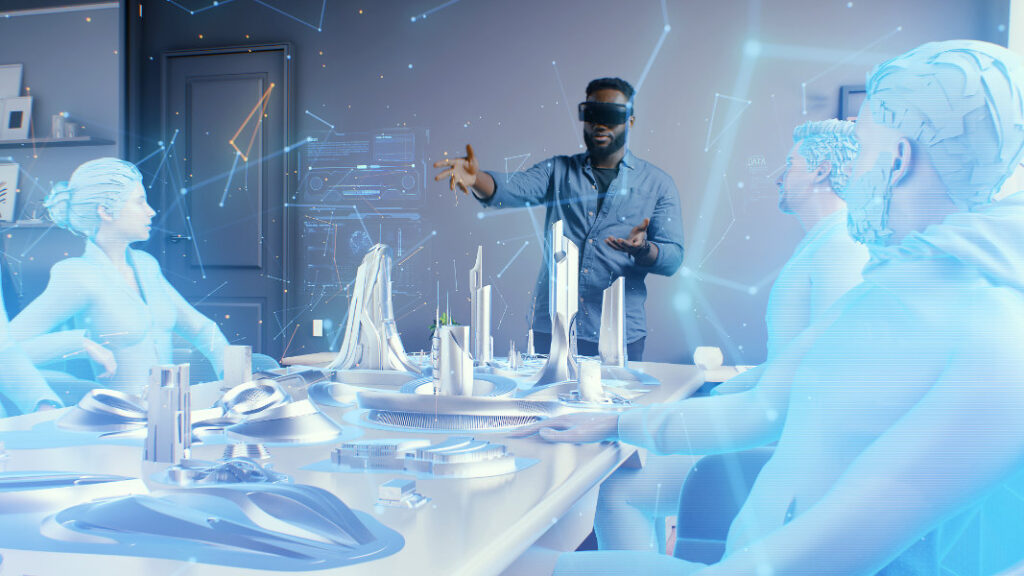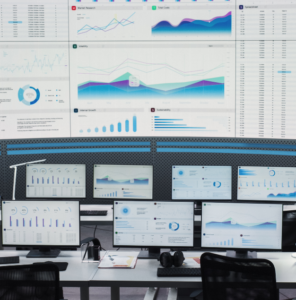24-09-2025
Blurring the Lines Between Physical and Digital
The future of AV systems is about to get a reality check, literally! Extended reality (XR) in AV, covering VR (virtual reality), AR (augmented reality) and MR (mixed reality), is transforming how people collaborate, present and learn in spaces such as meeting rooms, conference halls and lecture theatres. As designers of audiovisual systems, this presents Lucid with an extraordinary opportunity to create deeply immersive experiences that unite the physical and digital like never before.
Extended Realities Meet Audiovisual Systems
Imagine stepping into a meeting room where a remote participant appears as a hologram in full 3D, standing beside you. Or an auditorium where lecture visuals pop into the room with interactive 3D models of molecules, architectural renderings, or data visualisations you can gesture around. These XR advances elevate traditional audiovisual solutions into engaging, spatial experiences.
XR Possibilities Across Different Environments
In Meeting Rooms
XR-enabled boardrooms will empower teams to collaborate seamlessly with virtual attendees who feel present. AV control interfaces let users summon holographic charts or 3D dashboards via touch or voice.
At Conferences and Events
Hybrid event stages could overlay virtual presenters onto physical platforms, mixing on-camera feeds with holographic speakers or immersive lighting effects. XR transforms flat AV setups into multi-sensory storytelling platforms.
In Lecture Theatres and Educational Settings
In education, XR provides immersive learning. For example students can explore anatomical 3D models or walk through historical reconstructions. When integrated into audiovisual systems, XR supports teaching, streaming and interactive learning in one cohesive solution.
What is Possible Using XR in AV?
What’s Possible Now (2025)
- Augmented Reality (AR) – overlays via tablets, phones or headsets (E.g. HoloLens or Magic Leap) are already in use for training, design reviews and exhibitions.
- Virtual Reality (VR) – widely used in higher education, design and training. Some universities already employ VR lecture tools.
- Hybrid Events – remote presenters are integrated via LED walls, 3D visualisation and high-quality AV systems (though not true holograms, yet).
- Interactive 3D Models – projected or controlled through AV systems for teaching, product demos or architecture.
Near Future (2–5 years)
- Improved Headsets – lighter, more affordable, mixed reality glasses will make XR practical for everyday classrooms and meetings.
- Spatial Collaboration Tools – Microsoft Mesh and Apple’s Vision Pro are paving the way for shared XR workspaces with avatars.
- Smarter AV Integration – control systems will handle XR as seamlessly as video or slides, lowering technical barriers.
- Partial Holographic Displays – volumetric and holographic panels could appear in premium venues within 5 years.
Longer Term (5–10 years)
- Seamless Holograms – life-sized, interactive holographic participants could become reality in boardrooms.
- Widespread Lecture Theatre Adoption – universities may deploy XR-integrated AV as standard, enhancing in-person and remote learning.
- XR Standard in AV Systems – just as video conferencing is now, XR could become a baseline expectation in AV design.
Realistic Outlook
- Now – AR/VR is already in place within some niche, high-value AV solutions.
- 2–5 years – we expect to see the mainstream adoption of AR/VR in classrooms, collaboration spaces and flagship conferences.
- 5–10 years – we expect to see the widespread integration of XR into standard audiovisual solutions with simpler, affordable hardware.
The Human Factor and Future Outlook
As XR becomes more prevalent, user-centric design is fundamental. AV systems must remain intuitive and activation should not require technical expertise. Whether it is lecture content, cross-campus collaboration, or immersive client presentations, simpler, smarter control interfaces will keep XR accessible.
Looking forward, XR in AV will redefine spaces, where boardrooms, lecture halls and event stages become portals to virtual collaboration, learning and creativity. By embracing extended reality in AV, audiovisual systems can deliver unforgettable, future-ready experiences that truly blur the lines between physical and digital.
Please get in touch to find out how we can improve your AV systems now and in the future.





